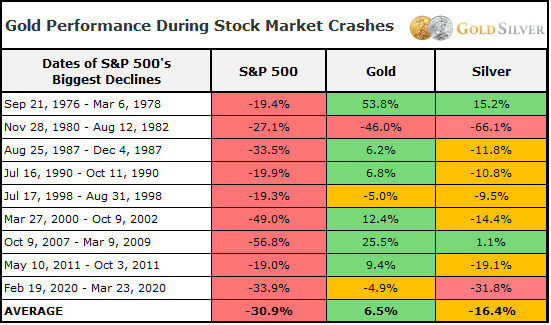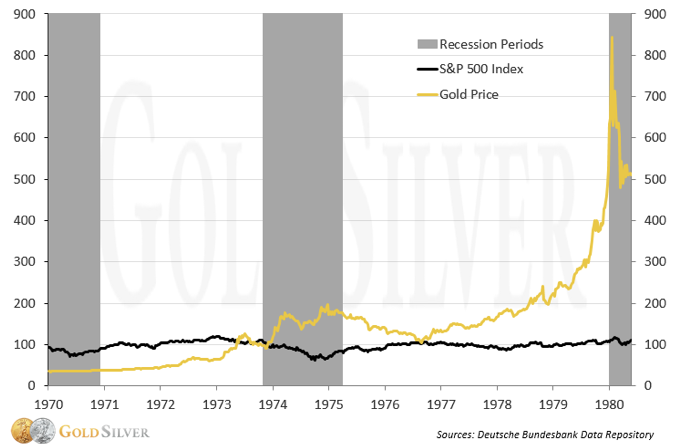what happens to gold mining stocks great reset
Many investors hold gilt and argent to hedge against various economic crises. Simply does this hedge concur up during stock market crashes? Knowing what upshot a market place plunge and subsequent dollar collapse will have on silver and aureate is vital to making investment decisions now and then deciding what course to take should a major recession or depression occur.
It'due south a common assumption that golden and silvery prices will fall right along with the market place. And if that'southward the instance, wouldn't it be better to wait to buy them until afterwards the dust settles? Simply suppose that the investors have information technology right and that their precious metals do retain their value — or even gain value. During a low, is it meliorate to hold gold or silver? In other words, which one is going to give you the best adventure of weathering the tempest?
Before formulating a strategy, permit's first look at price data from by stock market crashes… and see what it can tell us that might influence investment decisions.
The Message from History
To assistance answer the questions posed in a higher place, I looked at past stock market place crashes and measured golden and silver'due south operation during each of them to see if there are whatever historical tendencies. The following tabular array shows the eight biggest declines in the S&P 500 since 1976 and how gold and silvery prices responded to each.
[Note: Green signifies the value rose when the S&P crashed, red means it barbarous more than than the S&P, and yellow denotes it fell but less than or the same as the S&P.]
What Happens to Gilt and Silverish During Stock Market Crashes

At that place are some reasonable conclusions we can depict from this historical data.
1. In about cases, the aureate price rose during the biggest stock market place crashes.
Does aureate go up if a stock plunge occurs? In recent times, the respond has ordinarily been, "Yeah!" Notice this was regardless of whether the crash was short-lived or stretched over a couple years. Gold fifty-fifty climbed in the biggest crash of them all: the 56 percent decline that lasted two total years in the early 2000s. It seems clear that we should not assume gold will autumn in a stock market crash — the verbal opposite has occurred much more than often.
2. Investors shouldn't panic over an initial driblet in gilt prices.
You'll call up that gilt did fall in the initial stupor of the 2008 financial crisis. This recent, admitting memorable, instance is perchance why many investors call up aureate will drop when the stock market does. But while the South&P connected to refuse, aureate rebounded and ended the year up v.5 percentage. Over the full eighteen-month stock market selloff, gold rose more than 25 percentage. The lesson hither is that, even if gold initially declines during a stock market place plummet, one should non assume information technology's down for the count. In fact, history says it might be a great buying opportunity.
iii. Gold'due south only significant selloff (46% in the early on 1980s) occurred just after its biggest bull marketplace in mod history.
Gilded rose more than than 2,300 percent from its depression in 1970 to the 1980 peak. So it isn't terribly surprising that it fell with the broader stock marketplace at that point. In recent years, the situation has been the exact opposite. Gold endured a 45 percent decline from its 2011 summit to its 2016 depression, which was one of its worst bear markets in modernistic history. At the same time, this isn't entirely a shock either, given its quick gains during the 2008 crisis and the 2011 crash.
4. Silverish did non fare then well during stock market crashes.
In fact, it rose in only one of the S&P selloffs and was basically flat in some other ane. This is likely due to silvery's high industrial utilize (well-nigh 56% of total supply) and that stock market place selloffs are usually associated with a poor or deteriorating economy. However, you'll see that silver fell less than the South&P in all simply one crash. This is meaning because argent's high volatility would usually cause it to fall more. Also notice that silver's biggest rise (+15% in the 1970s) took place among its biggest bull market in history. It also ended flat past the end of the financial crunch in early 2009, which was its second-biggest bull marketplace. In other words, we take historical precedence that silver could practise well in a stock market place crash if it is already in a bull market. Otherwise, it could struggle.
The overall message from history is this:
• Odds are high that gold won't fall during a stock marketplace crash, and in fact, it will likely rise instead. Silvery might depend on whether information technology'southward in a bull marketplace.
So, why does gilded conduct this way?
Gilded's Yin to the Stock Market'south Yang
The reason gold tends to be resilient during stock market crashes is that the two are negatively correlated. In other words, when i goes up, the other tends to go downwards.
This makes sense when yous think almost information technology. Stocks do good from economic growth and stability while gold benefits from economical distress and crisis. If the stock market falls, fear is usually high, and investors typically seek out the safe haven of gold. If stocks are rockin' and rollin', the perceived need for golden from mainstream investors is depression.
Historical data backs up this theory of negative correlation between aureate and stocks. This nautical chart shows the correlation of gold to other common nugget classes. The zilch line means golden does the opposite of that investment half of the time. If the line is below nil, gold moves in the reverse direction of that investment more often than with it; if it's above zero, it moves with that investment more oftentimes than confronting it.
Stocks Take a Negative Correlation to Gold
You lot can see that, on boilerplate, when the stock marketplace crashes (U.Due south. Equities on the nautical chart), gold has historically risen more than than declined. Aureate has besides historically outperformed the greenbacks sitting in your depository financial institution account or coin market fund. Even real manor values follow gilded only a piddling more half the fourth dimension.
This is the practical conclusion for investors:
- If you lot desire an asset that will rise when nigh other assets fall, gold is likely to do that more often than not.
This doesn't mean gold volition automatically rise with every downtick in the stock market. In the biggest crashes, though, history says gold is more probable to exist sought as a safety haven. So if you think the economy is probable to be robust, y'all may want to own less aureate than usual. If you think the economy is headed for weakness, then you may want more than gold than usual. And if you think the economy is headed for a period of upheaval, you lot may want to ain a lot.
In that location's i more possibility we have to consider…
What if the Stock Market Doesn't Crash?
It's not always easy to predict if stocks volition autumn off a cliff. So what if they don't? Or what if the market is just apartment for a long period of time? You might recollect that'due south unlikely, given the number of risks inherent in our economic, fiscal, and monetary systems today. But look at the 1970s — information technology had iii recessions, an oil embargo, interest rates that striking xx percent and the Soviet invasion of Transitional islamic state of afghanistan. Here'south how the South&P performed, along with how gold performed.
Gold Rose 2328% Trough to Peak While the Due south&P 500 Was Flat

The S&P basically went nowhere during the entire decade of the 1970s. After x, years information technology was up a measly xiv.3 percent (excluding dividends). Gold, on the other hand, posted an incredible return. Information technology rose from $35 per ounce in 1970 to its January 1980 peak of $850, a whopping 2,328 pct.
In other words, gold'southward biggest bull marketplace in modern history occurred while the stock market was substantially flat. That'due south because the catalysts for higher gold were unrelated to the stock marketplace — they were more well-nigh the economic and inflationary issues occurring at the fourth dimension. Nosotros have to allow for the possibility that this happens again and that citizens are fatigued to gold for reasons unrelated to the performance of the Southward&P.
How Long information technology Takes to Recover from Stock Market Crashes
Stock brokers will sometimes point to 100-twelvemonth chart of the stock market and show that it always somewhen recovers and heads college, fifty-fifty after large crashes. What they don't show, however, is how long it takes to recover after accounting for inflation.
Some stock marketplace crashes have taken a long time to get back to even—then long, in fact, that if the investor were to spend the gain they'd find that the same corporeality of cash wouldn't purchase them as much. Because the recovery took so long, inflation eroded their purchasing power, despite gaining dorsum all that they'd lost in the crash.
Believe it or not, the amount of fourth dimension it takes to regain one's purchasing power after the biggest stock market crashes is measured in years.
What nosotros know from history is that the best defense force against both the prospect of a stock market crash and the corroding furnishings of aggrandizement is gilded.
The Investor's All-time Strategy
Anything can happen when markets are striking with boggling volatility. But regardless of what stocks might do, is it wise to be without a meaningful amount of concrete gold and silver in low-cal of all the risks we face up today? I don't think and then.
Perhaps the ideal solution is to have a stash of greenbacks ready to deploy if we get some other big decline in precious metals — only to also have a stash of bullion already set aside in instance the next crunch sends gilded off to the races.
Browse Our Catalog
Follow Jeff on Twitter @TheGoldAdvisor
Well-nigh Jeff Clark
An active investor with a love of writing, Jeff Clark is a globally recognized potency on precious metals. As the son of an award-winning aureate panner, with family-owned mining claims in California, Arizona, and Nevada, Jeff has deep roots in the industry. Jeff regularly speaks at precious metals conferences, serves on the board at Strategic Wealth Preservation in Grand Cayman, and provides sectional assay and market commentary to GoldSilver customers.
Source: https://goldsilver.com/blog/if-stock-market-crashes-what-happens-to-gold-and-silver/

0 Response to "what happens to gold mining stocks great reset"
Post a Comment